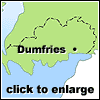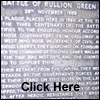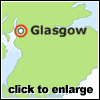
|
The Covenanters - The Pentland Rising - Rullion Green
By Brian Orr Have a question? Click Here to go to Brian's own Discussion Board!
Pressure had been building on the Covenanter ministers from 1662, when about 300 were ejected from their churches, and in 1664 two more rules were introduced which prohibited any ejected minister living within 20 miles of his former church. Severe penalties were imposed on parishioners who failed to attend church services conducted by curates appointed by the government. The protesters came mainly from the West of Scotland, from Dumfries and Galloway, Ayrshire, and Lanarkshire, where the ministers who had been ejected from their churches continued preaching by holding open air meetings, called "Conventicles". To hold such meetings was an offence and many suffered for it, but their flock grew, especially among the peasantry.
The crowd gathered and reckoning that they would be severely punished they decided to march on Dumfries. On their way they repeated their deed in Balmaclellan where they took 16 soldiers prisoner, killing one. So it happened that a band, now grown to about 250, took prisoner their zealous persecutor and local military commander, Sir James Turner. At Bridge of Doon, the Covenanters found their military leader in Colonel James Wallace of Auchens , an experienced soldier who joined them along with his deputies Major Learmouth, Captain Arnot and Captain Paton of Meadowhead. Now having some professional leadership, the gathering multitude marched to Ayr. They collected further recruits at Mauchline and Lesmahagow and by the time they had swung round to Lanark they numbered about 1200. On November 25, they reached Colinton about five miles from Edinburgh where messengers advised that the gates were armed with cannon and there was no support for their cause in the city. With this disheartening news it was decided to return to Galloway.
Several of the wounded Covenanters were brought in by country people and others were shot or slain in their flight and were buried in neighbouring kirkyards of Penicuik and Glencorse. The kirk session records of Penicuik lists a payment to a grave digger of 3s 4d for "making westlandmen's graves". Colonel Wallace survived the battle and went to Holland leaving a terrible condemnation of the local people who, he said, left the Covenanters unburied for a day and a night and stripped the bodies of their apparel. It was the women of Edinburgh who came and wrapped the bodies with winding sheets and buried them. About 30 prisoners were hanged at the Mercat Cross in Edinburgh and at various places in the South West as a warning to others. Many of the wounded are believed to have died in the bogs when trying to reach their homelands in the West.
Rullion Green lies about 8 miles south of Edinburgh on the slopes of the Pentland Hills and was, as now, prime sheep country. On the fringe of a small wood there is a railed enclosure containing a single headstone commemorating the events of 1666. In April, 2000, the inscriptions on the solitary stone were indecipherable and badly in need of cleaning. The following detail is from The Buried Barony, p 156, by Alasdair Alpin McGregor, published by Robert Hale & Co, London (1949 ).
Side 2. A cloud of witnesses lyes here, who for Christ's interest did appear For to restore true Liberty Overturned then by Tyrrany And by Proud Prelats who did rage Against the Lord's own heritage. They sacrificed were for the Laws Of Christ their King, his noble cause, These heroes fought with great renown, By falling got the Martyr`' Crown. The Pentland Rising came as a great shock to the Earl of Rothes, the Commissioner for Scotland, and his cohort, Archbishop Sharp, who had earlier sought the King's permission to bring back the Court of High Commission to deal with the summary trial and conviction of the troublesome Covenanters. With these absolute powers the persecution of the Presbyterians took a bloody turn. Prisoners from Rullion Green were hauled before the Court and ten of their number hung on December 7, 1666 . After death their right hands were cut off and sent to be nailed to the prison door at Lanark and their severed heads sent to their respective home areas to be exhibited as a warning. Five more were executed on December 14 and six more on December 22 - a bloody Christmas message indeed for the Covenanters. Elsewhere there was a bloody price paid. In Ayr, eight men were sentenced to hang but the official hangmen from Ayr and nearby Irvine both declined to act. One of the prisoners, Cornelius Anderson, was bribed, made drunk and acted as hangman for the remaining seven. Anderson also acted as hangman at the execution of two more Covenanters in Irvine.
So it was that the Pentland Rising was put down but it left a fear in the government: they had seen that the Covenanters were capable of banding together and could be an effective military force. On the other hand, the excesses of retribution by the Earl of Rothes were subject to political pressures and he was replaced in 1667 by John Maitland, Earl of Lauderdale, a humane man under whom repression eased for a while.
Meet the Author, Brian Orr, Researcher with The Guild of One Name Studies
Back to The Covenanters, Main Page
Part One: The Covenanters: Who Were They?
|
Thursday, December 26th, 2019
Attention visitors: Tartans.com is back. Please note that this is a snapshot of the site as it existed nearly 20 years ago and you may encounter broken links; we are still combing through the site and correcting those as we find them. Please also note that some sections are currently not functional, primarily the discussion forums/clan chat boards.
|
** HOME - First Time Visitors - Glossary - - Contact Us ** Awards | Bibliography | Clan Calendar | Clan Chat | Clan Finder | History | Famous Scots | Genealogy | Great Hall of the Clans | Links | News and Features | Scots on the Net | Search | Site Map The Gathering of the Clans
Copyright 1995- Tartans.com - All Rights Reserved. |





